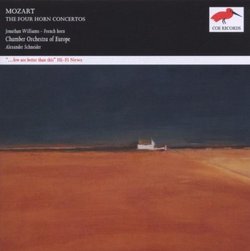| All Artists: Wolfgang Amadeus Mozart, Alexander Schneider, Chamber Orchestra of Europe Title: Mozart: The Four Horn Concertos Members Wishing: 0 Total Copies: 1 Label: Coe Records Original Release Date: 1/1/2006 Re-Release Date: 10/17/2006 Genre: Classical Styles: Chamber Music, Forms & Genres, Concertos, Historical Periods, Classical (c.1770-1830), Instruments, Brass Number of Discs: 1 SwapaCD Credits: 1 UPC: 680125080523 |
Search - Wolfgang Amadeus Mozart, Alexander Schneider, Chamber Orchestra of Europe :: Mozart: The Four Horn Concertos
 | Wolfgang Amadeus Mozart, Alexander Schneider, Chamber Orchestra of Europe Mozart: The Four Horn Concertos Genre: Classical
![header=[] body=[This CD is available to be requested as disc only.]](/images/attributes/disc.png?v=15401716) ![header=[] body=[This CD is available to be requested with the disc and back insert.]](/images/attributes/disc_back.png?v=15401716) ![header=[] body=[This CD is available to be requested with the disc and front insert.]](/images/attributes/disc_front.png?v=15401716) ![header=[] body=[This CD is available to be requested with the disc, front and back inserts.]](/images/attributes/disc_front_back.png?v=15401716) |
Larger Image |
CD Details |
CD ReviewsConcerto No. 4 is the most interesting of these. Tom Brody | Berkeley, CA | 02/20/2010 (4 out of 5 stars) "The disc contains four horn concertos. The music is mild, but there are momentary whirling episodes, where the music is briefly exciting. In these concertos, the Andantes are the most interesting, as they contain tuneful melodies. The most distinctive feature of these concertos, of course, is that the ear is treated to the sombre tones of the French horn. (This is in contrast, for example, to the "saucy" tones of an oboe.)
No. 1 is 8 minutes and 7 seconds long. The Allegro has a tune sounding like a children's summer camp song, or perhaps like COLUMBIA THE GEM OF THE OCEAN. The Rondo has a less predictable and has more interesting tune. The Rondo would be fine for contra dancing, that is, for those people who like contra dancing. No. 2 is 12 minutes and 51 seconds long. The Allegro begins with a whirling motif. The horn provides a little skittering motif. At 5 min, the music momentarily dips into the minor key. At 4 minutes, the major key returns. The Andante is slow, with interesting chord progressions, and an interesting and distinct tune. In the Rondo, the horn provides a stacatto motif, going, "Ta-ta-ta, ta-ta-ta, ta-ta-ta." The Rondo is like a square dance. There are some pauses (moments of silence) where you can imagine couples bowing to each other during the course of their square dance. No. 3 is 14 minutes and 51 seconds. The Allegro begins with a splashing effect from the strings. After this initial splash, the music is subdued until around 2 minutes, when things pick up a bit. At 3 minutes, a minor key briefly makes an appearance. At 5 minutes, a whirling motif occurs, but it does not last long. At 6 min to 6 1/2 min, the horn solos in absence of the other instruments. The Larghetto has a hummable tune, but the this tune is not really an interesting one. At 2 1/2 minutes, comes a dramatic part, but POOF, as soon as things get more exciting, the hummable tune returns. The Allegro has a tune where the horn part and strings part are integrated with each other. No. 4 is 16 minutes and 22 seconds. The Allegro starts with a dramatic whirlwind theme. Then, the horn is featured prominently, where it romps up and down and up and down and up and down, with no particular melody. Halfway through the Allegro is a morose-sounding solo, sounding like, WHERE OH WHERE HAS MY LITTLE DOG GONE. At 4 1/2 mintues, the whirlwind theme returns again. The Andante sounds like a slow, romantic love ballad. Once can easily imagine the tune from the Andante being sung by Jack Jones, Bobby Vinton, or Johnny Mathis. The Rondo is quicker and the horn sounds like it is signalling in Morse code, going, "Dit-dit-dit, dit-dit-dit, dit-dit-dit-dit-dit, dahhhhhh." CONCLUSION. For those interested in more varied and more tuneful pieces by Mozart, where catchy riffs and hooks are in abundance, I recommend the eternally majestic Adagio and Rondo in C minor for glass harmonica. Any person who listens to this glass harmonica piece by Mozart will find their life to be changed forever. Also, I recommend Mozart's Serenade in B flat (Gran Partita). Gran Partita was featured in the movie, AMADEUS. The Serenade in B flat is multi-colored, and features amusing chugging motifs from the wind ensemble. Love that chugging motif. Those who have seen the movie AMADEUS might recall actor F.Murray Abraham describing his wonderment and ecstasy over the Serenade in B flat. One does not need to be particularly patient or well-tutored in music to find lasting enjoyment in Mozart's Serenade in B flat. " |

 Track Listings (11) - Disc #1
Track Listings (11) - Disc #1